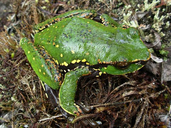|
Litoria angiana (Boulenger, 1915)
| family: Hylidae subfamily: Pelodryadinae genus: Litoria |
|
Taxonomic Notes: Following the Australian Society of Herpetology, AmphibiaWeb uses Litoria instead of Ranoidea or Dryopsophus (contrary to Dubois and Fretey 2016 and Duellman et al 2016). |
|
 © 2012 Marc Dragiewicz (1 of 1) |
|
|
|
Description Distribution and Habitat Country distribution from AmphibiaWeb's database: Indonesia, Papua New Guinea
Life History, Abundance, Activity, and Special Behaviors Reproduction: Eggs are large and unpigmented. Tadpoles are typical of frogs that are adapted to breed in similar places; the only difference is in size (Menzies 1975).
References
Menzies, J. I. (1975). Handbook of Common New Guinea Frogs. Wau Ecology Institute, Papua New Guinea. Zweifel, R. G. (1980). ''Results of the Archbold Expeditions 103. Frogs and lizards from the Huon Peninsula, Papua New-Guinea.'' Bulletin of the American Museum of Natural History, 165, 390-434. Originally submitted by: Chih Wang (first posted 2003-05-13) Edited by: Tate Tunstall (2003-05-14) Species Account Citation: AmphibiaWeb 2003 Litoria angiana <https://amphibiaweb.org/species/1216> University of California, Berkeley, CA, USA. Accessed May 28, 2025.
Feedback or comments about this page.
Citation: AmphibiaWeb. 2025. <https://amphibiaweb.org> University of California, Berkeley, CA, USA. Accessed 28 May 2025. AmphibiaWeb's policy on data use. |




 Map of Life
Map of Life